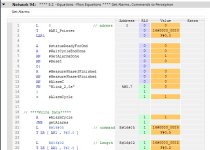swedeleaner
Member
Hello gurus!!
I would be really grateful if you could help me with sorting this out.
As you see, line 5 to 15 is conditions for sending the outcommands that starts at line 21.
At first, only row 5 to 8 existed and had direct acess to JNB.
I wanted to divide the AlarmCycle condition into two branches.
First branch, row 5 to 8 works like it should.
But when i added the OR, everything went very wrong...
Instead of executing one cycle every fourth second, it executes every scan cycle....
Why is AlarmCycle set to 1 when the condition isn´t met?
Is it the FN(negative pulse) that is configured wrong?
Or have i missed anything basic when writing STL?
To sum it up:
Row 5 to 8 OR Row 10 to 13 to set #Alarmcycle
This is a multi instance function block.

I would be really grateful if you could help me with sorting this out.
As you see, line 5 to 15 is conditions for sending the outcommands that starts at line 21.
At first, only row 5 to 8 existed and had direct acess to JNB.
I wanted to divide the AlarmCycle condition into two branches.
First branch, row 5 to 8 works like it should.
But when i added the OR, everything went very wrong...
Instead of executing one cycle every fourth second, it executes every scan cycle....
Why is AlarmCycle set to 1 when the condition isn´t met?
Is it the FN(negative pulse) that is configured wrong?
Or have i missed anything basic when writing STL?
To sum it up:
Row 5 to 8 OR Row 10 to 13 to set #Alarmcycle
This is a multi instance function block.





